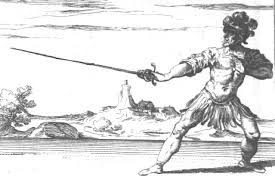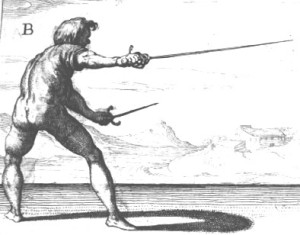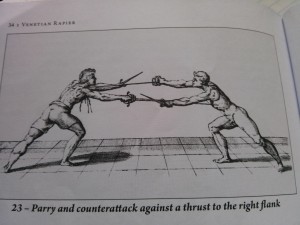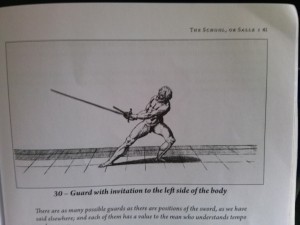Bodywork
Most ancient masters and modern instructors discuss footwork and bladework as the means of controlling access to your target area and creating access to your opponent’s target area. “Bodywork” – the movement of your torso to achieve these same goals – is rarely addressed except in the context of the voids previously addressed (ducking and leaning to get out of the way of an attack).
However, bodywork comes into play from the moment you come into guard. Most fencers are taught to stand in one particular way, with their left shoulder back to minimize target area – a holdover from strip fencing. However, a more adaptable guard keeps the fencer safer and readily forms counterguards.
Capoferro’s neutral terza looks more or less like the body position most fencers are taught when in guard (except for the backward lean to get the head and vitals even further out of range – which is an instance of bodywork increasing the distance your opponent must travel).
However, his guard when engaged to the outside is nothing at all like it. Instead, the torso leans inward and the left shoulder is brought forward.
To what end? The target area is moved further away from the opponent’s blade, this time laterally rather than linearly. Also, the sword arm extends straight at the opponent’s debole, keeping all of the body united behind the strong of the blade (the ricasso, elbow, right shoulder, left shoulder, left knee, and left foot are more or less in the same plane, just as they are in the terza guard).
Remember that with the inquartata the rotation of the upper body can move your sword from being found to having found your opponent’s blade. This can happen without a void and, depending on positioning, sometimes without any footwork at all (at most a small step to the outside or inside is sufficient). Leaning slightly back or forward can also change the angle enough to give you advantage. All of these motions are a matter of inches and fractiosn of inches. These gain control of the blade without any action on the part of the arm. If, in the tempo of one of these actions of the body, the opponent should cavazione, the hand is free to contracavazione and deliver the kill. By adding in these tempi of the body, you now free up more ways to exploit tempo.
In Giganti’s sword and dagger section he presents a number of plays that essentially end the same way: The dagger driving the opponent’s blade offline to the outside and the sword inline for the opponent’s chest or face. These sword and dagger positions are achieved almost entirely through bodywork from Giganti’s basic sword and dagger guard.
The lean of the body to the inside and forward, bringing the left shoulder forward (just like Capoferro’s guard above), while holding both weapons in position relative to the shoulders, raises the sword to seconda in the high line. Meanwhile, the angle of the dagger gains the opponent’s blade (in concert with the lunge or passing step, and extension of the arms, closing measure).
The above examples show bodywork controlling measure, tempo, and line – the essence of combat. Unfortunately, the manuals don’t go into much depth on how to expand this into general principles for application during the fight (“Move your body away from the sword” and “Keep your body aligned to exert force” seem ready lessons to take away). Also, the scope of any sort of distillation is beyond a mere blog post and probably beyond my knowledge of body mechanics (bodywork is one of the things I am consciously working on at present). Most importantly I could not do nearly as good a job as Steven J. Pearlman did in “The Book of Martial Power.” It has no discussion of fencing in it. Yet, it discusses the means of aligning the body to exert the most force or cover the most distance with the least effort; of positioning the body to be essentially immovable by your opponent’s efforts; and of shifting your line of attack by small movements of the feet, hip, torso, or shoulder.




Leave a Reply